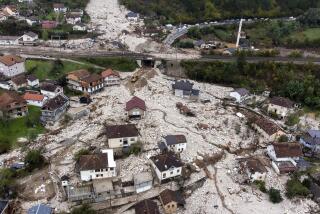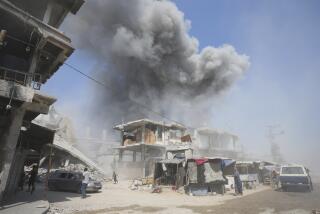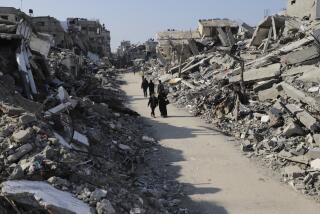U.N. Aid Convoy Enters Besieged Bosnian City
BELGRADE, Yugoslavia — The commander of U.N. forces in Bosnia-Herzegovina piloted an aid convoy through a gantlet of artillery fire to Srebrenica on Friday, but the besieged city, crammed with wounded and starving Muslim refugees, was reported to be on the verge of succumbing to the Serb rebel attack.
French Gen. Philippe Morillon rode triumphantly at the head of a 17-truck procession as it entered Srebrenica after a perilous 35-mile high-speed run through hostile Serbian sniper and shellfire.
Aid workers in the city reported that weak but joyous Muslims thronged the convoy to cheer Morillon for standing up to the Serbian gunmen who had blocked the convoy’s passage into Bosnia for the past nine days.
But while the rebels held the aid hostage, Serbian forces moved within a mile of the city, which has been worn down by their yearlong siege.
The desperate conditions in Srebrenica prompted U.N. High Commissioner for Refugees Sadako Ogata to appeal to the United States to send armored helicopters to evacuate the city’s most severely wounded. In Washington, Secretary of State Warren Christopher said the Clinton Administration is seriously considering the request. A decision to grant it would bring American air crews into range of Serbian artillery.
“It was an incredible act of personal courage to get this convoy through,” Lyndall Sachs, Belgrade spokeswoman for the Office of the U.N. High Commissioner for Refugees, said of Morillon’s fulfilled promise not to abandon the people of Srebrenica until at least one lifesaving convoy reached them.
The U.N. relief agency planned to immediately dispatch another shipment of goods because the 60,000 people in Srebrenica remained in dire condition, Sachs said.
“We’ll describe this as a breakthrough only when we get the second and the third and the fourth convoys through,” Sachs said.
The convoy arrived just before sunset and immediately began to unload its cargo to the tears and jubilation of Srebrenica’s people. As many as 40 residents have been dying each day from starvation and exposure, according to aid workers.
The city is one of only four areas of eastern Bosnia still under the Sarajevo government’s nominal control, although Serbian rebel forces have stepped up a 2-week-old offensive to crush the last enclaves and drive the surviving non-Serbs out.
Western diplomats and sources with the U.N. Protection Force contend Srebrenica is within days, possibly even hours, of falling.
Besides asking for U.S. helicopters, U.N. refugee commissioner Ogata also appealed to the United States to double the amount of food it has been parachuting in nightly aid drops over Srebrenica and the other holdout regions also cut off by Serbian gunmen and under siege.
U.S. military transport planes dropped 30 tons of aid over Srebrenica before dawn Friday, but relief workers said the landing area has become a prime target for Serb-launched shells landing on Srebrenica at the rate of one per second.
Srebrenica’s prewar population of 38,000 has been swollen during the latest Serbian offensive by thousands forced to flee other conquered communities. Many arrived on foot weakened by hunger and suffering bullet and shrapnel wounds from the failed attempts to defend their towns and villages.
The U.N. relief agency had included several ambulances and a team of doctors in its convoy for Srebrenica when the attempt to aid the embattled community began March 10, but Serbian guerrillas in the Bosnian border town of Zvornik who set the conditions for the convoy’s passage refused to allow any help for Srebrenica’s wounded. Two Belgian doctors were forced to stay behind at Zvornik, as was the convoy’s nine-vehicle protective escort.
U.N. sources here said the convoy headed by Morillon was fired at repeatedly as it traveled through Serb-held territory, especially around the city of Bratunac.
The 180 tons of food, medicine, blankets and stoves was the first relief to reach Srebrenica by road since early December and it was only the third convoy allowed through since the Serbian siege began nearly a year ago.
Bosnian Serbs, backed by the nationalist regime in Serb-dominated Yugoslavia, have been waging a bloody rebellion against Bosnian independence since a majority of the republic’s population--mostly Muslim Slavs and Croats--voted in a referendum last March to secede from the former Yugoslav federation.
Bosnia had no organized armed forces at the time and the Serbs, armed and instigated by Belgrade, launched the siege that has left 150,000 people dead or missing, most of them Muslim civilians.
The most recent rebel campaign to take the last government strongholds in eastern Bosnia has been supported by Yugoslav warplanes, which U.N. observers spotted last weekend making bombing raids over Srebrenica. It was the first confirmed air attack since the U.N. Security Council imposed a “no-fly zone” over Bosnia in October, although there have been more than 400 violations recorded by peacekeeping forces.
Among the Serbian, Croatian and government factions fighting in Bosnia, only the Serbs have aircraft. However, some of the flights in violation of the no-fly order were made by police and military planes and helicopters flying from the neighboring republic of Croatia, U.N. monitors have reported.
The persistent violations and the confirmed air raids last weekend have angered Western governments and spurred louder calls for U.N. enforcement of the toothless no-fly order.
More to Read
Sign up for Essential California
The most important California stories and recommendations in your inbox every morning.
You may occasionally receive promotional content from the Los Angeles Times.











